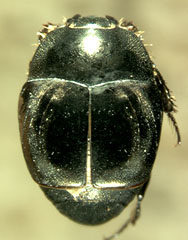Saprininae
Michael S. Caterino- Saprinodes (2 species)
- Notosaprinus (1 species)
- Saprinus (>150 species)
- Myrmeosaprinus (3 species)
- Satrapister (1 species)
- Phoxonotus (~5 species)
- Euspilotus (~90 species)
- Xerosaprinus (~25 species)
- Geomysaprinus (~33 species)
- Chelyoxenus (1 species)
- Aphelosternus (1 species)
- Styphrus (3 species)
- Zorius (2 species)
- Chalcionellus (~25 species)
- Pholioxenus (~7 species)
- Axelinus (1 species)
- Saprinillus (1 species)
- Hypocacculus (~93 species)
- Chivaenius (1 species)
- Hypocaccus (~80 species)
- Exaesiopus (~7 species)
- Neopachylopus (~4 species)
- Pachylopus (2 species)
- Paravolvulus (~10 species)
- Reichardtiolus (2 species)
- Ammostyphrus (1 species)
- Gnathoncus (~23 species)
- Eremosaprinus (~6 species)
- Tomogenius (~5 species)
- Paramyrmetes (1 species)
- Myrmetes (1 species)
- Reichardtia (1 species)
- Eopachylopus (1 species)
- Xenonychus (2 species)
- Philothus (~15 species)
- Ptenophilothis (2 species)
- Paraphilothis (1 species)
- Xenophilothis (1 species)
- Terametopon (3 species)
- Monachister (1 species)
- Philoxenus (1 species)
Introduction
Saprininae is one of the two ‘big’ subfamilies of Histeridae (along with Histerinae). However, while the two are similar in numbers of species as well as ecological diversity, Saprininae exhibit very little morphological diversity by comparison. Such taxonomic comparisons can only be taken so far, but the contrast is interesting. Saprininae contains over 600 species in about 40 genera. While all the major continents have their own unique lineages, some genera (or groups of closely related genera), such as Hypocaccus and Saprinus are virtually cosmopolitan.
Saprininae exhibit a diverse array of habits. Many species are common dung and carrion specialists. Others specialize in various vertebrates’ nests and burrows. A few genera have become obligate myrmecophiles. Saprininae are especially diverse in sandy habitats. Some genera are restricted to inland dunes, while others are found in sandy riparian and beach habitats. Hypocaccus, mentioned above, has species on nearly all the world’s beaches.
Characteristics
Saprininae are rather uniform in appearance, showing the typical ovoid histerid body shape. But they are generally easy to identify (at least under the microscope). The prosternal lobe is usually very short and truncated in front, and the antennal clubs rest in cavities on either side of it. The antennae are never covered by laterally extended prosternal ‘alae’. Two sets of prosternal striae are nearly always present, and their varied arrangements provide diagnostic characters for most of the genera.
Discussion of Phylogenetic Relationships
Phylogenetic relationships among the genera of Saprininae are in great need of attention. As is likely true throughout the Histeridae, the larger genera (Saprinus, Hypocaccus, Euspilotus) will likely be found to be paraphyletic with respect to many of the smaller.
References
Caterino, M. S., and A. P. Vogler. 2002. The phylogeny of the Histeroidea. Cladistics 18(4):394-415.
Kovarik, P. W., and M. S. Caterino. 2001. Histeridae. Pages 212-227 in American Beetles (R. H. Arnett, and M. C. Thomas, eds.). CRC Press, Boca Raton.
Kryzhanovskij, O. L., and A. N. Reichardt. 1976. Beetles of the Superfamily Histeroidea. Fauna SSSR, Novaya Seriya 111:1-432.
Mazur, S. 1991. New North America histerids. Annals of Warsaw Agricultural University - SGGW Forestry and Wood Technology 42:89-96.
Mazur, S. 1997. A world catalogue of Histeridae. Genus (Supplement):1-373.
Information on the Internet
Masahiro Ohara’s Histeridae home page: SaprininaeTitle Illustrations

| Scientific Name | Neopachylopus sulcifrons |
|---|---|
| Location | California, USA |
| Specimen Condition | Dead Specimen |
| Image Use |
 This media file is licensed under the Creative Commons Attribution-ShareAlike License - Version 3.0. This media file is licensed under the Creative Commons Attribution-ShareAlike License - Version 3.0.
|
| Copyright |
© 2002

|
| Scientific Name | Saprinus discoidalis |
|---|---|
| Location | California, USA |
| Specimen Condition | Dead Specimen |
| Image Use |
 This media file is licensed under the Creative Commons Attribution-ShareAlike License - Version 3.0. This media file is licensed under the Creative Commons Attribution-ShareAlike License - Version 3.0.
|
| Copyright |
© 2002

|
About This Page

Santa Barbara Museum of Natural History, Santa Barbara, California, USA
Page copyright © 2002
 Page: Tree of Life
Saprininae.
Authored by
Michael S. Caterino.
The TEXT of this page is licensed under the
Creative Commons Attribution License - Version 3.0. Note that images and other media
featured on this page are each governed by their own license, and they may or may not be available
for reuse. Click on an image or a media link to access the media data window, which provides the
relevant licensing information. For the general terms and conditions of ToL material reuse and
redistribution, please see the Tree of Life Copyright
Policies.
Page: Tree of Life
Saprininae.
Authored by
Michael S. Caterino.
The TEXT of this page is licensed under the
Creative Commons Attribution License - Version 3.0. Note that images and other media
featured on this page are each governed by their own license, and they may or may not be available
for reuse. Click on an image or a media link to access the media data window, which provides the
relevant licensing information. For the general terms and conditions of ToL material reuse and
redistribution, please see the Tree of Life Copyright
Policies.
- First online 07 March 2002
Citing this page:
Caterino, Michael S. 2002. Saprininae. Version 07 March 2002 (under construction). http://tolweb.org/Saprininae/9380/2002.03.07 in The Tree of Life Web Project, http://tolweb.org/










 Go to quick links
Go to quick search
Go to navigation for this section of the ToL site
Go to detailed links for the ToL site
Go to quick links
Go to quick search
Go to navigation for this section of the ToL site
Go to detailed links for the ToL site